General Assembly of the International Society for Historic Preservation in the GDR (ICOMOS), Rostock and Dresden - Germany / German Democratic Republic 1984 - 15 Pfennig
Theme: Architecture
| Country | Germany / German Democratic Republic |
| Issue Date | 1984 |
| Face Value | 15.00 |
| Color | green |
| Perforation | K 14 |
| Printing Type | Rotogravure 2 |
| Stamp Type | Postage stamp |
| Item Type | Stamp |
| Chronological Issue Number | 2612 |
| Chronological Chapter | GER-DDR |
| SID | 222753 |
| In 20 Wishlists | |
Denkmalpflege-ICOMOS On the occasion of the General Assembly of the International Society for the Preservation of Monuments in the GDR, the Ministry of Posts and Telecommunications of the German Democratic Republic issues four multicolored special postage stamps. Special cancellation from April 24 to June 23, 1984 Preservation of monuments 15-pfennig value: Albrechtsburg in Meissen As an early feudal fortress to subjugate the Slavs in the former Milziner Land founded in 928-929 by King Henry I. 968 raised by Emperor Otto I to the diocese. Since that time center of the spiritual and temporal power of the Meissen country. The Albrechtsburg as a former residence of the margraves or Saxon Electors, as well as the cathedral with the bishop's castle are still clearly recognizable as witnesses of the former power position. Instead of the old Markgrafenburg, the construction of the Albrechtsburg was started as a sovereign castle in 1471 by Arnold von Westfalen, finished around 1489. The castle served the Wettinern only a short time as a residence, as soon after its completion Dresden was raised to the final residence. Around 1520-1525 further expansion, 1662 restoration work after damages in the Thirty Years' War. From 1710-1864 Albrechtsburg was home to the Meissen Porcelain Manufactory. 1855-1870 comprehensive renewal and painting with illustrations from the history of Meissen and Saxony. Extensive restoration measures in exterior and interior construction have been initiated since the 1960s. The Albrechtsburg is a versatile building organism of three storeys with large and small Wendelstein on the court side. Upstairs are the ballrooms. Particularly noteworthy are the cell vaults in richly varied figuration. The building is epoch-making in the history of Central European castle architecture, which is about to be transformed into castle construction. The design language Arnold of Westphalia, such. For example, the curtain windows and cell vaults influence the late Gothic architecture throughout Central Europe.


